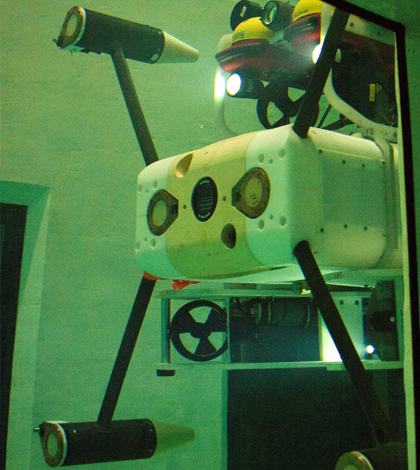Millennium Falcon ROV to improve ocean observatories, offshore energy development

A new remotely operated vehicle and sensor package combination in development at the University of Washington is looking to ease operations for the offshore energy industry. Built to deliver complex monitoring equipment to the seafloor, the ROV bears the name of another famous smuggler: the Millennium Falcon.
But the ROV isn’t the biggest achievement of the effort. As those involved say, the Millennium Falcon is a “dumb system” because it really just does one thing, deliver packages. The real value of the ROV is the complex box of sensing devices it can deliver to the seafloor for hooking up with energy-supplying conduits there. UW scientists are developing that too, and call it the Adaptable Monitoring Package because it holds a slew of environmental monitoring tech useful for those studying the effects of offshore energy generation on marine life.
“We were using a Saab Falcon ROV,” said Brian Polagye, assistant professor of mechanical engineering at U. Washington, in explaining the ROV’s out-there moniker. “And so we had to customize it. We needed a name.”
One of his grad students suggested the name on a whim and it stuck. He admits that the package the ROV carries looks similar to the Rebel Alliance’s X-Wing starfighters. “And we all probably like Star Wars a little too much,” he quipped.
The effort began back in 2012, and scientists at the school didn’t have a prototype monitoring package until the following year. Construction of the devices began the next year, and testing of the whole system got underway in 2015.
The real need for an ROV-monitoring package combo was realized even before that though, says Polagye. Difficulty of development, as well as the expenses and scientific heft needed, kept others from jumping at the opportunity to be the first to put something like it together.
“It’s one of those things where now that we have it developed everybody’s saying, ‘That’s a great idea, can we get one?’” said Polagye.
Now that the combination has been developed, this “great idea” holds huge promise for ocean monitoring efforts and offshore energy work. This is because having the ability to deploy and retrieve complex sensing devices or equipment from the seafloor means that only one underwater power conduit needs to be placed, netting huge savings for a green energy industry in its infancy.
The capability also helps researchers looking to maintain sensor performance and data accuracy because they can use it to retrieve and deploy monitoring packages more regularly. Those are big advancements over research projects of today that often send long mooring lines down to the ocean floor and then attach vertical profilers for data collection.
“My hope is that it gets used in the marine energy industry to learn more about how marine life interacts with tidal wave converters, which could make it easier to service offshore energy installations,” said Polagye. “But for ocean observatories as well, just general environmental monitoring in coastal areas where it’s hard to put instruments down and get them back.”

University of Washington researchers prepare to test the Millennium Falcon ROV and Adaptable Monitoring Package in a tank on campus. (Credit: Applied Physics Lab, U. Washington)
The system is still in its first stage of development, but quite capable. Future versions look to incorporate cross-communication between the ROV and the monitoring package and then hopefully complete automation of the ROV by adding a computer onboard.
For now, the AMP includes an array of hydrophones for tidal and wave study; cameras that capture depth of field and width; two active sonars; and a click detector for studying marine mammals. This coordinates to turn on the cameras when a mammal is close. Researchers are also working on a Doppler profiler to measure waves.
“The idea is that we could adapt to any instrument we want to put in there,” said Polagye.
Testing of the ROV and monitoring package is underway in Puget Sound during February, where researchers are putting everything through its paces to make sure it can get connected to an underwater conduit without difficulty in calm water.
“Next month we’ll be in the ocean with more waves and currents,” said Polagye. “And the Strait of Juan de Fuca this summer, a channel that’s relatively shallow where there’s PNNL (Pacific Northwest National Laboratory) infrastructure we can use during endurance tests.”
Top image: The Millennium Falcon ROV and Adaptable Monitoring Package in an underwater test. (Credit: Applied Physics Lab, U. Washington)




0 comments